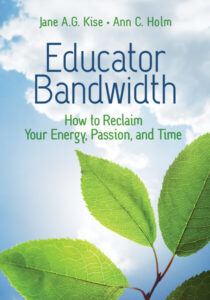How to Reclaim Your Energy, Passion, & Time
Educator Bandwidth: How to Reclaim Your Energy, Passion, and Time
By Jane Kise and Ann Holm
(ASCD, 2022 – Learn more)
Reviewed by Stephanie Choate

However, when I start the year after the summer, I am full of energy and excitement. I’ve often wondered to myself, how do I maintain that energy throughout the year?
In addition, as a Department Chair I’m always trying to make sure my colleagues don’t experience burn out. As both an educator and leader in my community, I know I need to help myself in order to help others.
Enter Educator Bandwidth

The book offers an extensive, but not cumbersome, bandwidth survey in the back of the book, with a whole chapter dedicated to analyzing the results. You can even take the quiz online and get your results via email. I scored an 80, which places me on the higher end of the Mediocre Bandwidth range.
However, I’m sure the fact that I took the survey at the end of a relaxing summer versus in the midst of a busy school year impacted my score, which supports the authors’ claim that bandwidth is fluid and there are many circumstances that impact our brain energy at any given time.
Kise and Holm make a great point about looking at the results using “blameless discernment.” It’s important not to over-assign blame to any one area (ourselves, others, circumstances) and focus more on the behaviors necessary to improve our bandwidth. At the end of each chapter there is a “blameless discernment moment” to help us reflect upon the ideas presented in a healthy and balanced way.
Before discussing the six key factors that contribute to bandwidth, Kise and Holm address individual responsibility and community responsibility. While our bandwidth is impacted by the routines of our institutions, we need to take responsibility for the decisions we make as well.
The book underscores that it’s not individual or community – it’s individual and community. There is an “interdependent” relationship between these two factors, and both greatly impact our bandwidth at any given time. It’s about how we use our own time as well as how our schools respect our work/life balance that ultimately allows action steps to be taken in order to improve the bandwidth of everyone in the community.
Ways you can impact bandwidth
The book then discusses six factors that impact bandwidth: balancing priorities, filtering through possibilities, focusing through mental habits, fueling your brain, staying connected, and making time work for you. I found the organization of each chapter engaging and thought provoking.
The beginning of each chapter highlights a section from the bandwidth survey where you can look at specific questions that pertain to the topic at hand. After that, there is a curiosity creator, which is often a reflection or short activity, and then there are discussion questions at the end of the chapter as well.
In addition, there are individual pathways and leadership pathways to improvement listed at the end of each chapter. In this way, you can work on improving your own bandwidth and also look at ways for your institution to promote norms that allow your bandwidth to increase. This highlights the interdependent relationship introduced in the beginning of the book.
Interpreting your survey results
The end of the book focuses more on the survey itself and how to interpret results– and then offers suggestions on how to make changes for the better. I found the behaviors listed under my score were very accurate, and I was able to see how (and better understand why) my behaviors would change if my bandwidth increased or decreased.
If a large portion of a learning community completes the survey, then the institution can look for patterns so that both the educators and the leadership teams of the school can work together to incorporate some of the tips from the book.
While time may be precious, I am glad I made it a priority to dedicate some of mine to read this book. I look forward to taking the survey at key moments of the school year to see how my results change and hopefully improve.
Stephanie Choate is the English Department Chair and a teacher at Austin Preparatory School. A lover of Shakespeare, rhetoric, and young adult literature, Stephanie facilitates workshops with the PD Collab, has presented at a Keeping the Wonder workshop, and is also a trained executive function tutor. You can find her work and book recommendations on her Instagram: @scarvesandseminars.





































It’s so true that time is always on our minds, and the struggle to maintain energy throughout the year is real. I really like the concept of finding contentment in how we use our time instead of constantly trying to stretch it further. It’s all about how we look at things, isn’t it?